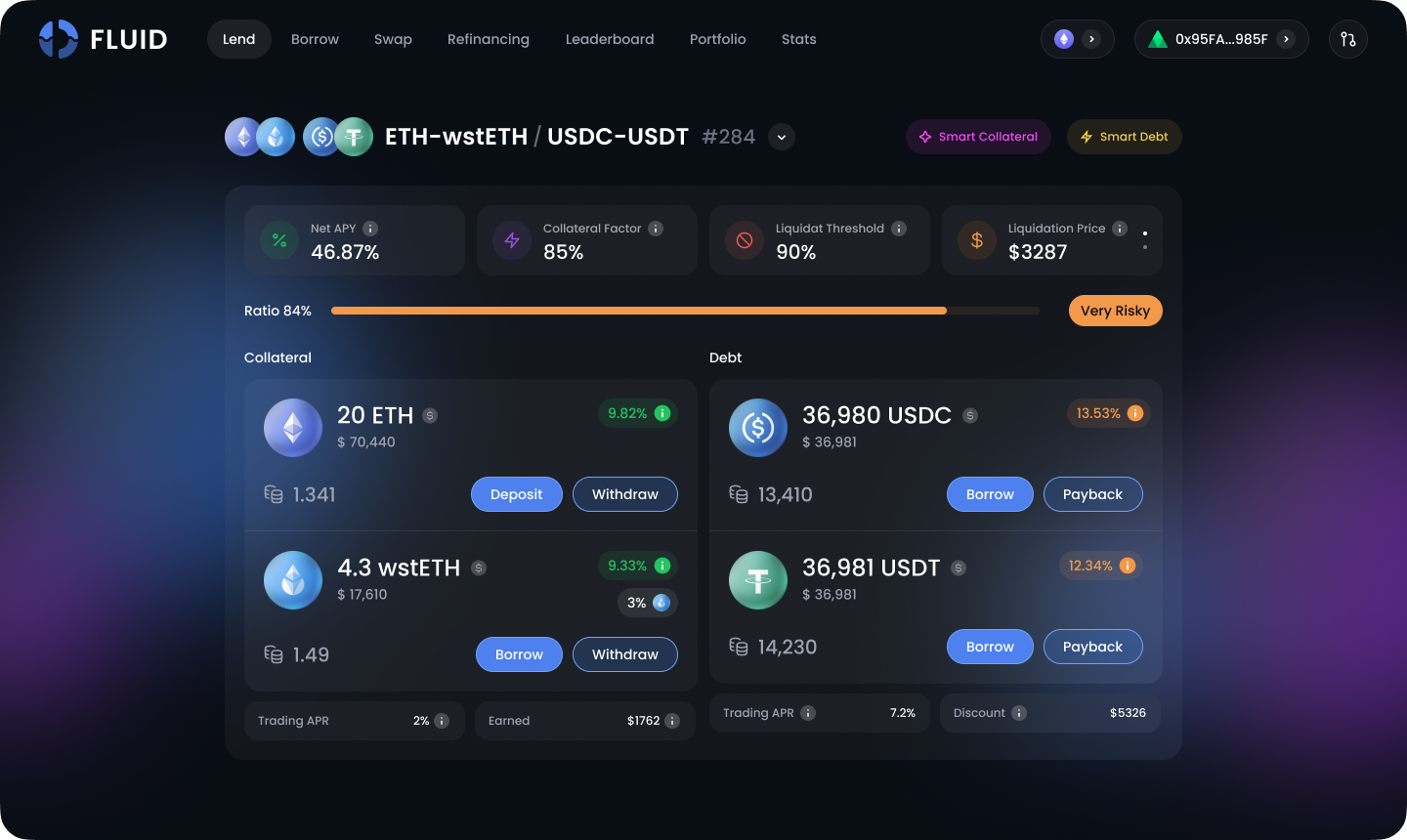Introducing Fluid DEX!
By enabling the debt as trading liquidity, Fluid DEX generates up to $39 in liquidity per $1 in TVL, making it the most capital-efficient and scalable decentralized exchange powered by the Liquidity Layer.

After innovating on top of protocols like Uniswap, Aave, Curve, Maker, and many others through Instadapp since 2018, we identified fundamental blockers to DeFi scalability that the market wasn’t resolving and created Fluid with the vision of building the most efficient, secure, and scalable DeFi ecosystem.
This vision includes a money market (the existing lending & borrowing protocol), a decentralized exchange (the DEX), and an underlying Liquidity Layer that lets liquidity flow across these protocols and, in the future, many others to be built on top of it.
The lending and borrowing market is live and flourishing, with a market size that has surpassed $800M in the first 3 months, powered by the Liquidity Layer. Today, we present the third piece of the triad — the decentralized exchange.
NOTE: If you’re completely new to Fluid, we recommend reading the Introducing Fluid blog first, yet it’s not required to understand this one!
DEX protocol
The DEX protocol is a novel protocol that is built on top of the Liquidity Layer and introduces Smart Debt and Smart Collateral. This will empower users to utilize their debt and collateral as liquidity for trading purposes. The v1 of the DEX protocol will be similar to a combination of Uniswap v2 and Uniswap v3 — single auto rebalancing range order UX like Uniswap v2 and concentration like Uniswap v3.
Pool aka “range order” can be of any size, have any fee, and any proportion. For example, for pairs like ETH<>wstETH, 80% of liquidity can be in ETH and 20% in wstETH, for pairs like ETH<>WBTC, 50% of liquidity can be in ETH & 50% can be in WBTC, etc.

Smart Collateral
Smart Collateral is a single range order that enables users to multipurpose their capital, using it as collateral to borrow against it, lend it, and deploy it as AMM liquidity on the DEX to earn trading and lending fees simultaneously.
Initial potential Smart Collaterals can be ETH<>wstETH, ETH<>weETH, ETH<>WBTC, USDC<>USDT etc. Governance can also explore trading-focused Smart Collateral such as ETH<>USDC, ETH<>USDT, etc.
Smart Debt
Smart Debt allows the debt to be turned into a productive asset by using debt as trading liquidity, therefore earning trading fees that offset the cost of capital incurred by borrowing (APR). Smart debt can be considered as the inverse of any AMM pool.
Initial potential Smart Debts can be ETH/wstETH, ETH/weETH, USDC/USDT, etc. Governance can also explore trading-focused Smart Debt such as ETH<>USDC, ETH<>USDT, etc.
Use cases:
Smart Collateral and Smart Debt enable the creation of different types of strategies and allow users access to the best rates in the ecosystem, earning more on their collateral and receiving discounts on their debt.
1. Normal Collateral & Smart Debt
This kind of vault enables users to leverage normal collateral while getting a discount on debt via trading fees. Normal collateral includes ETH, WBTC, wstETH, weETH, UNI, etc., while the Smart Debt includes USDC<>USDT, ETH<>wstETH, etc.
2. Smart Collateral & Normal debt
This kind of vault enables users to earn on their collateral through trading fees while holding normal debt. Smart Collateral options include ETH<>wstETH, ETH<>WBTC, ETH<>weETH, and more. Normal debt includes assets like USDC, USDT, ETH, and others.
3. Smart Collateral & Smart Debt
These kinds of vaults allow users to earn on both collateral and debt through trading fees, potentially maximizing your position's benefit. This can be used for 2 purposes: normal borrowing focus or trading focus.
Normal borrowing focus:
Smart Collateral options include ETH <> wstETH, ETH <> WBTC, ETH <> weETH, etc.
Smart Debt includes assets like USDC <> USDT, etc.
Trading focus, having the same Smart Collateral & Smart Debt:
i) Collateral: wstETH <> ETH & Debt: wstETH <> ETH.
ii) Collateral: USDC <> USDT & Debt: USDC <> USDT.
iii) Collateral: ETH <> USDC & Debt: ETH <> USDC.
Diving deep into trading-focused vaults
Users who take advantage of Smart Collateral and Smart Debt become liquidity providers for the DEX by using their collateral and debt as liquidity. Trading-focused vaults allow traders to leverage their LP positions, earning high trading fees with leverage.
For instance, by using a vault with wstETH<>ETH as Smart Collateral and Smart Debt at a 95% loan-to-value (LTV) ratio, you can achieve 20x leverage. This makes an effective LP position of ~39x (20x collateral and 19x debt). Hence it creates 39x worth of LP liquidity from 1x worth of assets and is now earning 39x the trading fees.
Similarly, with Smart Debt & Smart Collateral like ETH<>USDC at 80% LTV, users can reach up to 9x effective liquidity (and 9x trading fees!), combining 5x collateral and 4x debt.
Revenue
DEX protocol could also bring 3 more revenue streams and allow Fluid to generate one of the highest revenues among all DeFi protocols:
- Cut from trading fees
- Organic borrowing demand for assets like wstETH, weETH, sUSDe from the Smart Debt
- Smart Vaults might have an extra fee, for example, 1% extra on Smart Debt of USDC <> USDT
Initial fees will be determined by the $INST holders upon governance proposal to launch Fluid DEX.
Risks and Market Scenarios
While Fluid is utilizing the same liquidity for the DEX and Lending, there are no liquidity crunch risks during the market crash or surge.
Market crashing
In case of a sudden market crash, the market is selling ETH for USDC. Hence the LPs of the DEX protocol will take ETH and give USDC to traders, increasing ETH liquidity in the protocol, thereby increasing ETH liquidity in overall Fluid — hence doing the opposite of liquidity crunch.
Let’s compare the WBTC/ETH pair. Comparing past data, ETH is more volatile than BTC. So, when the market is crashing, then technically the market is selling ETH for BTC. Hence, increasing ETH liquidity in Fluid.
Any other tokens other than ETH. ETH is less volatile than any other crypto like UNI, LINK, stETH, eETH, etc. So, during the market crash, in these pairs ETH liquidity will go out of Fluid and other tokens liquidity will come in Fluid.
Overall, in any scenario of the market crash, Fluid will always have enough liquidity to process any liquidations while Fluid’s unique liquidation mechanism represents a 100x improvement over existing borrowing and lending protocols
Market surge
If the market is trending upward, the opposite is true. Liquidations will move closer to pairs like USDC collateral and ETH debt. In this market surge, more USDC will move into Fluid, while ETH will exit, thereby increasing USDC liquidity for seamless liquidation.
Fluid: A Look Ahead
With the highly efficient and scalable design, Fluid DEX is creating a new wave in DeFi innovation powered by the Liquidity Layer. Initially, Fluid will support prominent platforms like Lido and EtherFi, with plans to include additional LST, LRT, and stablecoin providers in the near future.
As Fluid prepares to launch the DEX in the coming weeks, it’s crucial to stay up to date with the latest developments and exciting announcements emerging from the Fluid DEX and ecosystem.
To stay tuned to Fluid updates, follow us and join the community:
Official links
Website https://instadapp.io/product/fluid
App https://fluid.instadapp.io/
Discord https://discord.com/invite/C76CeZc
Governance https://gov.instadapp.io/
